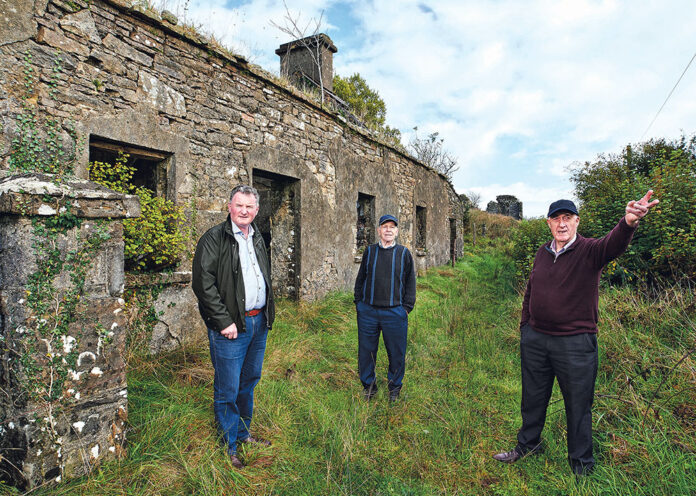The Currakyle Ambush is not as well known as some War of Independence actions, but that is about to change
THE East Clare Memorial Committee are to mark the centenary of one of the lesser known, but highly significant incidents in the War of Independence in this county.
Supported by Clare County Library under the Decade of Centenaries Project Awards, the committee will commemorate the Currakyle Ambush, when, according to local lore, ‘two took on 200’.
The event will take place in Flagmount Hall at 8pm on Friday, October 29 and will involve a lecture from Dr Tomás Mac Conmara and the recounting of stories and songs.
Chairperson of the committee, Councillor Pat Hayes, outlined the importance of remembering the Sixth Battalion of the East Clare Brigade.
“Often commemorations centre on events in relation to The Scariff Martyrs and The Feakle Ambush,” he said.
“This event will help to raise awareness of those who came from Flagmount, Killanena and Upper Feakle. In North East Clare, there were real leaders and it is important that the coming generations know about their contribution to where we are today.
“This is an opportunity to remember the events and those involved in the Sixth Battalion and in Cumman na mBan.”
According to historian, Dr Mac Conmara, the Sixth Battalion had active companies in Feakle, Annaghneale, Killanena, Flagmount, Caher and Dromondoora. As the War of Independence drew to a close, their ranks are thought to have numbered up to 367.
The battalion had various leaders during The Troubles, among them Pat Houlihan who was commandant and Seán Moroney, his second in command.
Dr Mac Conmara and Shane Walsh who have written the text for a new commemorative booklet, note that while the struggle for independence was a collective effort, involving active volunteers, supporters, safe houses and Cumann na mBan members, the figures of Seán Moroney and Pat Houlihan merit particular attention.
The authors, who have gathered extensive information through different witness accounts, have compiled a fascinating account of the ambush and those involved.
Pat Houlihan was born at Doorus, Caher, close to the shores of Lough Graney, on June 22, 1889. His father had been a Fenian and Pat quickly showed his eagerness to fight to secure Irish independence.
After the Easter Rising, Pat helped Liam Mellows evade British forces. His two sisters Annie and Bridget were active members of Cumann na mBan. On the orders of Cathal Brugha, Pat was sent into south Galway to organise the IRA there.
Early in June 1921, along with Sean Moroney from Gurtavrulla, Feakle, Pat was among a group of six IRA volunteers and scouts in the area of Turkenna Lodge.
The lodge, on the edge of the Slieve Aughty Mountains, had been a popular summer venue for the gentry for years. The IRA had planned to burn it to stop it being used by British forces.
While making their way towards the house, the IRA members, who also included Denis Moroney and Patrick O’Brien, were confronted by a large force of British military travelling from Woodford.
While the IRA men engaged immediately and opened fire, they soon discovered how strongly outnumbered they were.
Over the course of a number of hours, the volunteers inflicted as much damage as they could, eventually making their escape and hiding out overnight.
An account given by Sean Moroney details how a plane was seen overhead the following morning, searching the area and opening machine-gun fire as it circled for more than an hour.
The volunteer escaped with the help of some local scouts, while the military came to terms with their losses.
After the War of Independence ended, Pat took the anti-Treaty side in the Civil War. He was a staff officer of the 1st Western Division. He was arrested in September 1922 and interned until July 1924.
Three years later, he was elected to Dáil Éireann as a Fianna Fáil TD. While in the Dáil, he was a strong campaigner on behalf of his farming constituents and also raised the treatment of republican prisoners.
In 1937 he lost his seat and ended his political career. At the age of 72, he passed away in Raheen Hospital in Tuamgraney.
Sean Moroney took the same side in the Civil War and was imprisoned between 1922 and 1924. He emigrated to America, returning in the 1930s.
In 1933, he joined the Garda Siochana and rose to the rank of detective. His duties included driving Taoiseach Eamon de Valera. At the age of 60, he passed way. It was less than a year after he gave testimony to the Bureau of Military History.
In 1967, a joint memorial stone was installed to Pat Houlihan and Seán Moroney at Feakle Cemetery.
The significance of the ambush is summed up by Dr Mac Conmara and Shane Walsh who wrote:
“The ambush at Currakyle has not featured as prominently in the broader story of Clare’s War of Independence.
“However, in the parishes of Flagmount, Caher and Kilanena, talk of the Black and Tans, the struggle for independence and the republican story more generally, invariably evoke the shots fired in the landscape around them.
“A deep pride is felt and expressed. One rooted in the ground around them, knowing that men of that place, fought in that place and managed to drive what were an occupying army, from that place”.

